9 Best Canva Alternatives for Website Graphics (Expert Pick)
Are you looking for the best Canva alternatives?
Canva is an online tool that lets beginners create stunning images for their websites. It’s affordable and easier to use than Photoshop, but it may not be the best choice for everyone.
In this article, we will share some of the best Canva alternatives for creating breathtaking images for your WordPress website.
What Is Canva?
When you create a WordPress website, adding high-quality images is one of the best ways to improve the way users engage with your content.
You may want to make a logo for your website, create a website banner to grab the attention of your visitors and add images to your blog posts to create interest and break up the text.
However, most users are not designers and may lack the skills needed to use complex graphic design software like Adobe Photoshop.
That’s what makes Canva so popular.
Canva is a beginner-friendly alternative to Photoshop that runs on the web and doesn’t need to be installed on your computer. It comes with a huge number of helpful templates that let you create all types of stunning images for your website or online store using drag-and-drop.
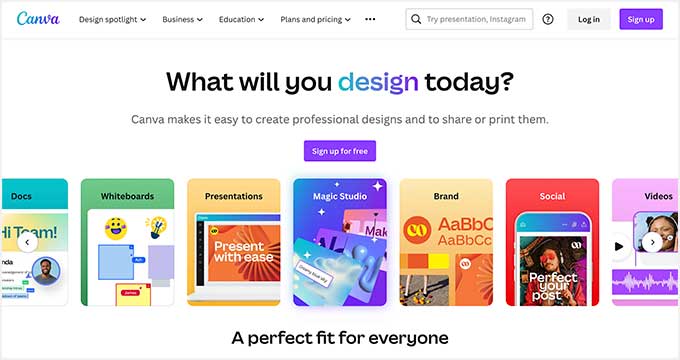
It’s a complete all-in-one graphic design tool that lets you enhance photos, design featured images and infographics, create product images, and much more. Pro members can use the app to develop a complete brand kit for their sites, including fonts, color palettes, and logos.
Best of all, Canva has affordable freemium pricing. You can use the app for free, and subscribing to the Pro plan gives you access to premium templates, photos, and icons.
Why Look For Canva Alternatives?
If Canva is so good, then why consider an alternative? Well, it comes down to personal preferences and the features you require to create your images.
Canva is an online tool, but some users may prefer to use graphic design software that is installed on their computer. Luckily, there are some excellent Canva alternatives for both Mac and Windows.
Other users may not need all of the features that Canva offers or prefer a tool that offers more specialized features. For example, on WPBeginner, many of our images are screenshots, and there are better apps designed with this use case in mind.
Some users have a limited budget and prefer to avoid ongoing subscriptions. And while Canva uses artificial intelligence for some features, some users may be looking for a graphics tool with stronger artificial intelligence (AI) capabilities.
With that being said, let’s take a look at some of the best Canva alternatives for website graphics.
1. Adobe Express (Online Graphic Design)

Adobe Express is Adobe’s answer for people who are looking for a Photoshop alternative with a lower learning curve that’s based in the cloud.
It offers image templates like Canva that help you get started on your images. Then, you can use its graphics editor to crop the image and add visual elements.
If you enjoy using artificial intelligence, then you will appreciate the app’s generative AI features, such as text-to-image tools and text effects. You can even come up with unique images and text styles by simply writing a prompt.

Adobe Express is free to use. There are also Premium and Team plans, and if you are already an Adobe subscriber, then you can use it with their other tools like Adobe Stock and Fonts to further enhance your blog post images.
Pros:
- Online tool
- More features than Canva
- Affordable freemium pricing model
- Works well with other Adobe services
Cons:
- Requires an internet connection
- Some features and resources are not included in the free plan
Why we chose Adobe Express: Adobe Express is an easier-to-use graphics tool by the people who create the industry standard, Photoshop. Like Canva, it is a web-based app that is designed to be easy to use.
2. Visme (Online Graphic Design)
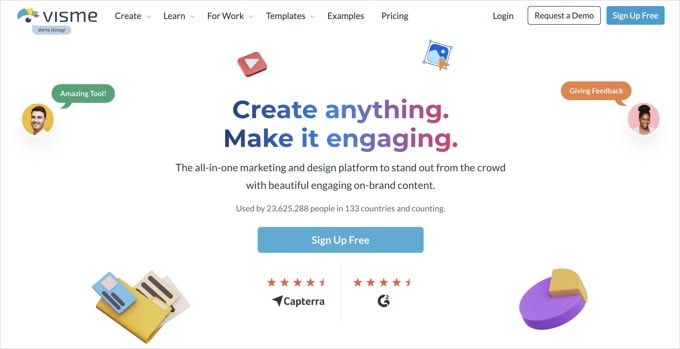
Visme has a lot in common with Canva. It’s a freemium web platform designed to let you create beautiful, engaging, and on-brand graphical content for your website.
Like Canva, it offers a vast library of templates, graphics, and customizable elements. This tool lets you easily create website banners, infographics, charts, and more to graphically enhance your site.
However, Vimse offers more features than Canva, making it a good choice for people who feel limited when using Canva.
For example, it is stronger at creating interactive content such as charts, maps, and data widgets. However, beginners will find it has a slightly steeper learning curve.
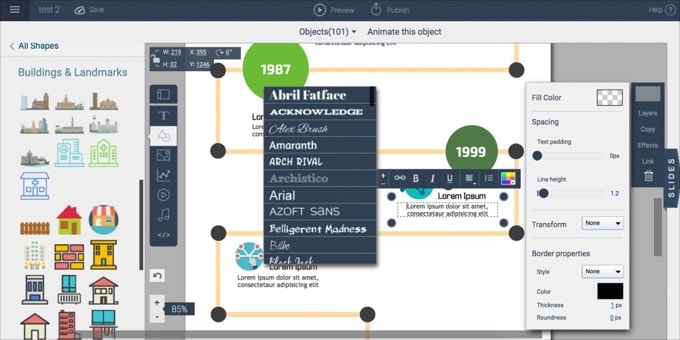
Pros:
- More features than Canva
- Online tool
- Affordable freemium pricing model
Cons:
- Requires an internet connection
- Slightly steeper learning curve than Canva
- Some features and resources are not included in the free plan
Why we chose Visme: Visme is a popular graphic design tool used by over 23 million people in 133 countries. It is affordable, web-based, and a close competitor of Canva.
3. Affinity Photo 2 (Photo Editor for Windows, Mac & iPad)
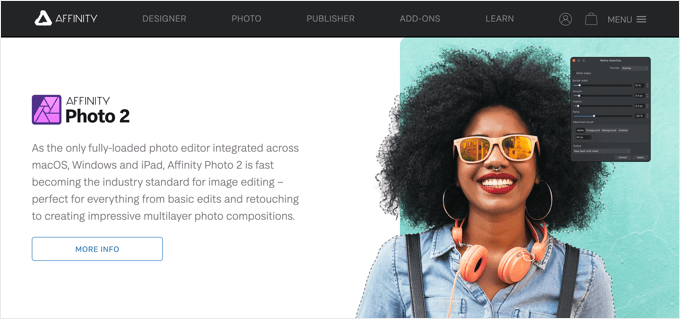
Affinity Photo 2 is full-featured photo editing software that runs on Windows, Mac, and iPad. It offers advanced tools and features similar to Adobe Photoshop.
While Canva is designed to cover a wide range of graphics tasks, Affinity Photo is focused on photo editing for people who need advanced features. However, the company also offers a whole suite of software to meet the needs of illustrators, designers, publishers, and more.
We use Affinity Photo, along with its sister program, Affinity Designer, to create many of the images on WPBeginner. With its advanced tools, beginners will find it has a steeper learning curve than Canva.
Affinity Photo can be purchased with a one-off payment for each platform, with no ongoing subscription required.
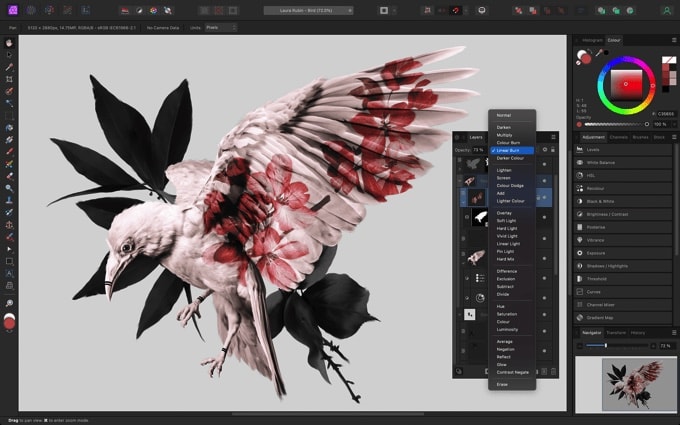
Pros:
- Advanced photo editing features
- Other Affinity apps are available for illustrators, designers, and publishers
- Available for Windows and Mac
- One-off payment with no ongoing subscription costs
Cons:
- A little expensive, especially if you purchase multiple apps
- Steeper learning curve than Canva
Why we chose Affinity Photo: Affinity Photo is an advanced photo editing tool that we use for images on WPBeginner.
Alternative: Pixelmator
4. Snagit (Screen Capture for Windows & Mac)
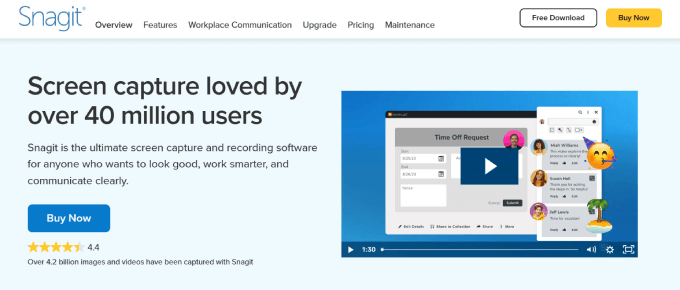
Snagit is not a direct competitor of Canva but is a better choice if you need to create a lot of screenshots for your website. You can use its screen capture feature to create and annotate screenshots and webcasts of the software you write about.
You can download the Snagit software for Mac and Windows with a single purchase. However, if you wish to access Snagit assets such as stamps, templates, themes, and photos, then an ongoing subscription is required.
Snagit lets you accurately specify which part of the screen you wish to capture and whether to preview it in the editor. The built-in Snagit editor gives you access to templates and flexible markup tools that let you customize your screenshots.
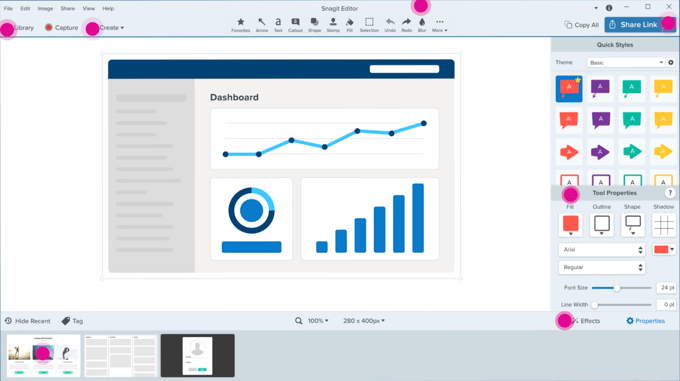
The application features text recognition that allows you to easily edit and customize the text in your screenshot. Besides that, it recognizes elements on the screen, such as buttons, and allows you to move or remove them.
Pros:
- Excellent tool for creating and marking up screenshots
- Available for Windows and Mac
- One-off payment with no ongoing subscription costs
Cons:
- Not an all-in-one graphic design tool
- An ongoing subscription is required for Snagit assets
Why we chose Snagit: Snagit is a highly rated screen capture application for Windows and Mac. If you create a lot of screenshots for your website, then it is a better tool than Canva.
Alternative: GreenShot (free and open-source software for Windows)
5. Piktochart (Online Infographic Maker)
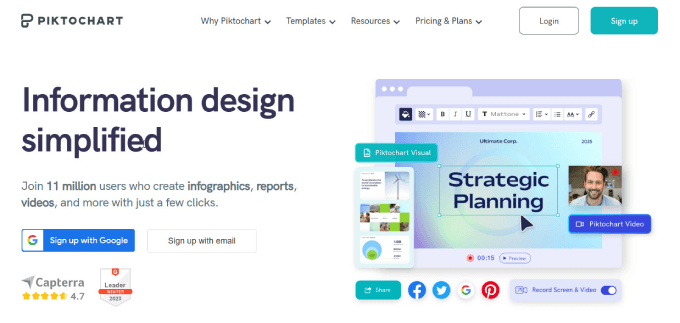
Piktochart is an easy-to-use online infographic maker. It provides over 600 professional templates that let you quickly create infographics, presentations, posters, and reports.
Once you’ve chosen a template, you can easily customize it using the drag-and-drop editor. There are plenty of free images, icons, and illustrations, and you can add your own charts and graphs, maps, icons, photos, and videos.
Piktochart can use AI to make creating images more efficient. For example, the Smart Templates feature automatically generates new templates tailored to your preferences, and Smart Suggestions recommends suitable fonts, colors, and icons to improve visual appeal.
Like Canva, it uses a freemium pricing model that lets you start to use the app free of charge, but with basic features and limited storage. Affordable paid plans remove these restrictions.
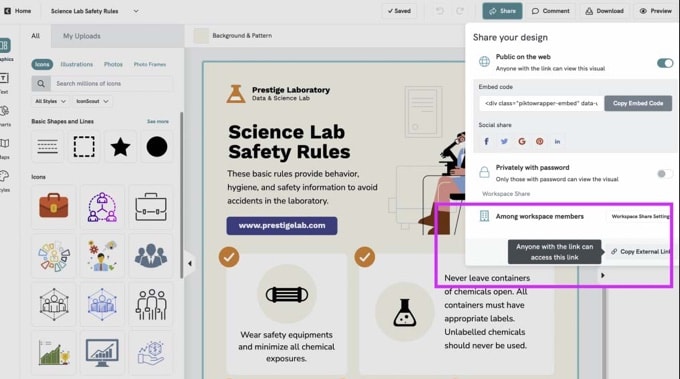
Pros:
- Online tool
- Focused on infographics
- AI tools to streamline image creation
- Freemium model with affordable plans
Cons:
- Requires an internet connection
- Free plan does not include all features
Why we chose Piktochart: Piktochart is an excellent alternative to Canva for users who create infographics and similar artwork for their blogs.
6. Pixlr (Online Photo Editor)
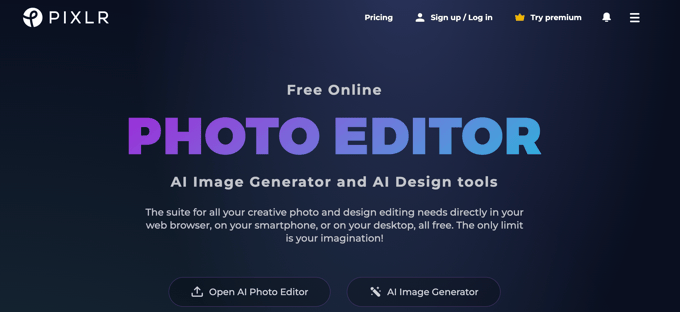
Pixlr is a freemium online photo editing tool that is created for beginners and non-designers. It offers similar features to Photoshop but in a beginner-friendly way. This makes it more powerful than Canva for photo retouching, detailed adjustments, and advanced editing.
Like Canva, Pixlr offers plenty of pre-made templates to help you get started, and you can customize your images to fit your content needs. It has affordable pricing, and the free version will suit many users’ needs.
Pixlr also lets you create new images using AI. Simply write a descriptive prompt that describes the type of image you need, and Pixlr will make it for you automatically.
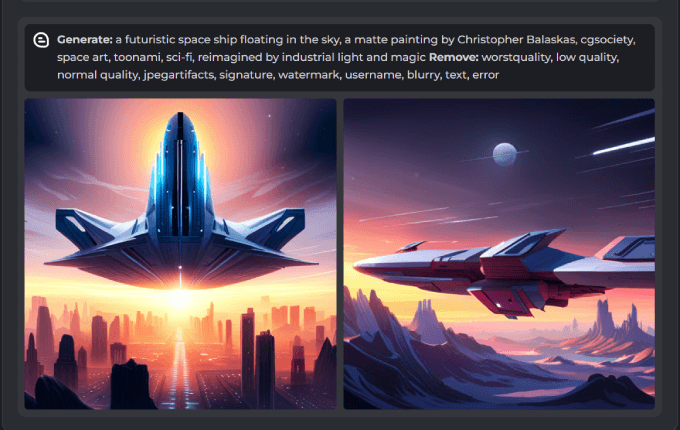
Pros:
- Advanced photo editing tools
- AI tools for creating new images from a prompt
- Online tool
- Affordable freemium pricing
Cons:
- Requires an internet connection
- The free version is ad-supported, has limited features and storage, and does not include AI tools
Why we chose Pixlr: Pixlr is similar to Canva in many ways but is much better than it is when it comes to advanced editing and artificial intelligence features.
7. Picmaker (Online Graphics Tool for Social Media)
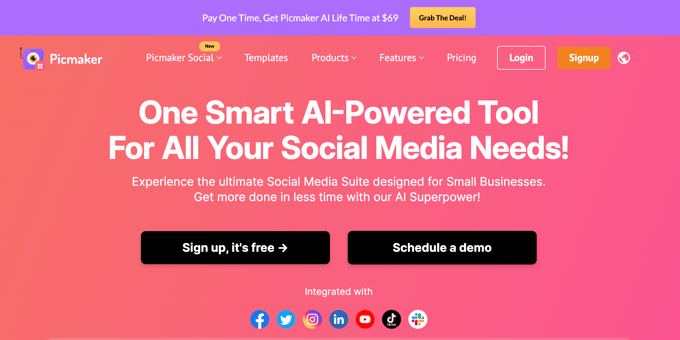
Picmaker is an easy-to-use online graphic design tool like Canva, but its features are focused on creating images for YouTube and social media. Both apps have easy-to-use interfaces and a library of templates that lets beginners get started on new designs quickly.
If you are a digital content maker focused on YouTube, then you will appreciate Picmaker’s tools and templates optimized for YouTube channel visuals. For example, it offers easy-to-use tools for creating YouTube thumbnails, channel art, and other visuals.
Picmaker uses AI to streamline the design process in a few ways. For example, it can use AI to analyze your preferences and recommend suitable templates and design elements like Canva does, and it also uses AI to help maintain brand consistency.
Picmaker offers both free and paid plans. However, you are likely to outgrow the free plan very quickly.
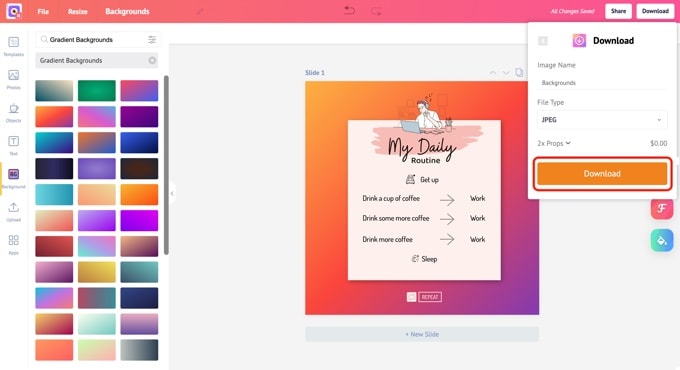
Pros:
- Online tool
- Affordable plans
- Features for creating YouTube and social media images
Cons:
- Requires an internet connection
- The free version lacks many features
Why we chose Picmaker: Picmaker is highly rated by its users. It is a good alternative to Canva for YouTubers and social media marketers.
8. Fotor (Online Photo Editor)
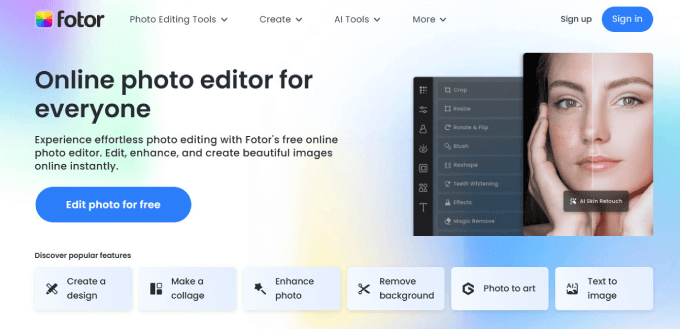
Fotor is a freemium online photo editing tool. It offers tools for photo editing, collage-making, and design and is suitable for users with varying levels of design experience.
While Canva offers a more versatile approach, Fotor is focused on photo editing and design. It provides tools for users who require detailed image enhancement and creative design options.
Fotor also includes several AI tools, including an AI background remover, AI photo object removal, and an AI image generator that allows you to create images by typing in text prompts.
The free version doesn’t include these AI tools, but otherwise will work well for many users. Paid plans are very affordable.
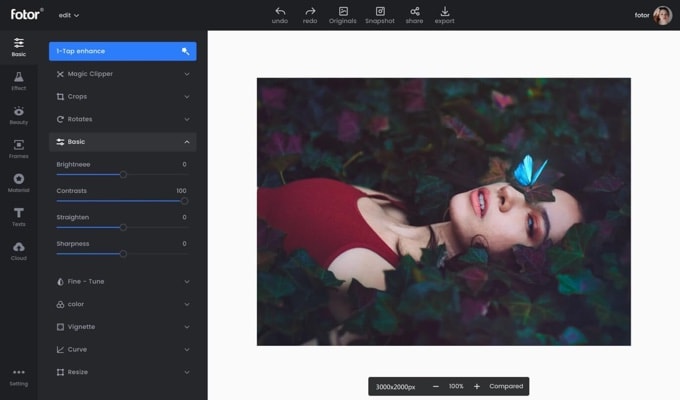
Pros:
- Online tool
- Includes AI features, including image creation
- Freemium pricing model with affordable plans
Cons:
- Requires an internet connection
Why we chose Fotor: Fotor is an affordable online photo editor with smart AI features.
9. PicMonkey (Online Graphics Tool for Social Media)
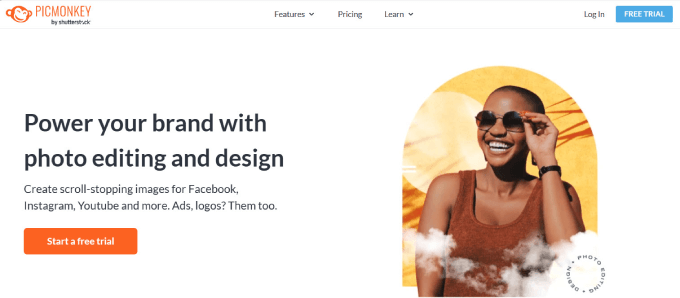
PicMonkey is an easy-to-use online image editor created by Shutterstock. Like Picmaker, it is focused on creating appealing images for YouTube and social media and includes templates for logos, banners, thumbnails, and more.
While Canva’s approach is more versatile, PicMonkey offers better photo editing tools and creative design capabilities, such as image retouching, filters, overlays, textures, and effects. It is more suitable for users looking for detailed image enhancement and design options.
The free version has ample features for creating stunning graphic designs. They also offer more powerful paid plans.
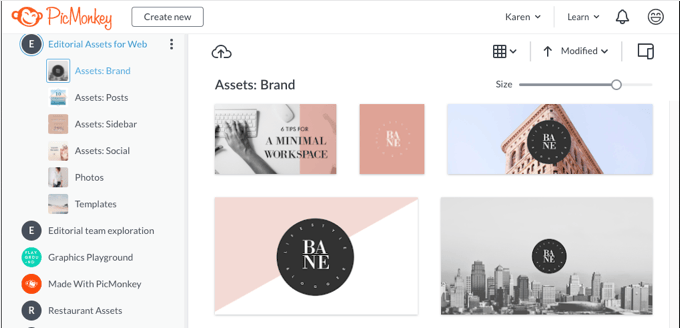
Pros:
- Online tool
- Features for creating YouTube and social media images
- The free plan will meet many users’ needs
Cons:
- Requires an internet connection
Why we chose PicMonkey: PicMonkey is an easy-to-use online tool suitable for YouTube and social media images.
BONUS: GIMP (Graphic Design for Windows, Mac & Linux)

GIMP is a powerful open-source alternative to Photoshop. While Canva and our other alternatives aim to make graphic design easier, GIMP provides a full-featured app for experienced graphic designers free of charge.
GIMP is suitable for users who require more advanced features and are not looking for a beginner-friendly interface. It offers a wide array of tools for photo retouching, image editing, and graphic design and is similar to Adobe Photoshop in many ways.
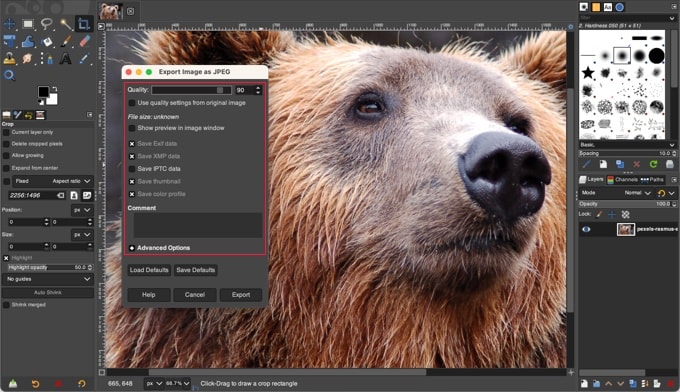
Pros:
- Open-source and completely free
- More powerful than Canva
Cons:
- Does not offer a wide range of templates as an easy starting point
- Has a high learning curve and is not beginner-friendly
Why we chose GIMP: GIMP is a popular open-source graphic design application. It’s suitable for experienced users who prioritize power over ease of use.
What Is the Best Canva Alternative?
Canva remains an excellent option for creating web graphics. It’s affordable, easy to use, quite powerful, and able to do a wide range of graphics tasks. And because it’s an online tool, it’s instantly available on any computer you use.
Visme is the best direct competitor. It’s a similar online tool that covers a lot of graphics tasks with an easy-to-use interface. However, it has a different user interface that may suit your workflow better.
However, if you prefer not to rely on an internet connection when doing graphic design work, then Adobe Express and Affinity Photo 2 are excellent choices. They can be installed permanently on Windows and Mac.
All of these apps cover a lot of ground and allow you to create all sorts of images quickly and easily. However, if you tend to create more specialized images, then there may be a better tool with the specific features that you need:
- For creating marked-up screenshots, Snagit has intelligent features that make it easy to take and customize screenshots on Windows or Mac.
- If you create images for social media or a YouTube channel, then Picmaker and PicMonkey are the best Canva alternatives.
- For creating infographics online, there’s no better choice than Piktochart.
- For detailed photo editing, Pixlr and Fotor are the best beginner-friendly online tools.
FAQs About Website Graphics
Our users regularly ask us questions about the best ways to use images on their websites. Here are some of the answers to the most frequently asked questions about website graphics.
What are website graphics, and why are they important?
Adding graphic elements to your website can make your content more identifiable, convey information, add interest, break up long blocks of text, and improve user engagement.
Typical website graphics include a website logo and banner for branding purposes and blog post images that may include a featured image, infographics, screenshots, and more.
What graphics file formats should I use for my site?
There are several types of image formats typically used on websites, and the format you should choose depends on the image itself.
PNG will give the best quality for images with a low number of colors, such as screenshots. However, they become very large when images have a lot of colors, such as photos. In this case, JPEG is a better choice. For animated images, GIF is the best format.
WebP is a new format that maintains better quality when compressed to smaller file sizes. However, because it is so new, it is still usually better to use one of the other formats.
For more information, see our guide on the best image format for WordPress.
What are the best practices for using graphics on a website?
It is important to optimize your images for small file sizes. Otherwise, your web pages may load too slowly. You should also aim for consistency in design that fits with your branding.
What are some copyright and licensing considerations for website graphics?
Make sure that you have the proper rights to use any website graphics that you didn’t create yourself, such as stock images.
This may involve purchasing a license or using royalty-free images.
Best WordPress Guides for Website Graphics
Now that you know the best Canva alternatives, you may wish to see some other guides related to website graphics:
We hope this tutorial helped you find the best Canva alternative for website graphics. You may also want to see our guide on how to fix common image issues in WordPress or our expert pick for the best Instagram WordPress plugins.
If you liked this article, then please subscribe to our YouTube Channel for WordPress video tutorials. You can also find us on Twitter and Facebook.
این خبر را در ایران وب سازان مرجع وب و فناوری دنبال کنید
